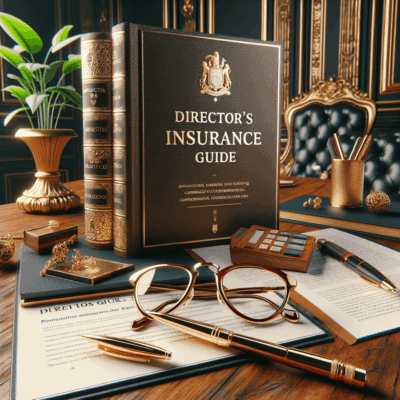The Essential Director’s Insurance Checklist: A Guide to Impartial Protection
Serving on a board of directors is a significant honor and a weighty responsibility. It signifies that your expertise, judgment, and leadership are highly valued. However, this elevated position also exposes you to a heightened level of personal financial risk. Legal actions can be brought against directors and officers for alleged wrongful acts, mismanagement, or breaches of fiduciary duty—even if the claims are ultimately groundless. The cost of defending such claims can be financially devastating.
This is where Directors and Officers (D&O) insurance becomes not just a corporate safeguard, but a critical component of your personal risk management strategy. Navigating the complexities of D&O policies, however, can be daunting. This comprehensive checklist is designed to provide an impartial framework to help you, as a director, understand, evaluate, and secure the robust protection you need. Its purpose is to empower you to ask the right questions and compare insurance policies effectively, ensuring your personal assets are shielded from corporate liabilities.
Understanding the Core: What is D&O Insurance?
Before diving into the checklist, it’s crucial to understand what D&O insurance is designed to do. At its heart, it is a liability insurance payable to the directors and officers of a company, or to the organization itself, to cover damages or defense costs in the event they are sued for alleged wrongful acts while managing the company.
A standard D&O policy is typically structured in three parts, often called “Sides”:
- Side A: Provides direct coverage to directors and officers when the company cannot indemnify them. This is the most critical protection for individual assets. For example, if the company is insolvent or legally prohibited from reimbursing legal costs, Side A steps in.
- Side B: Reimburses the company when it does indemnify its directors and officers for claims. This protects the company’s balance sheet.
- Side C: Provides coverage for the corporate entity itself. This is particularly relevant for securities claims against publicly traded companies but is also increasingly common for private companies.
The Comprehensive Director’s Insurance Checklist
Use this detailed checklist as a guide when reviewing your organization’s existing D&O policy or when evaluating a new proposal. An impartial review based on these criteria will reveal the true strength of the coverage.
Phase 1: Foundational Policy Assessment
1. Policy Type and Structure:
- Understand the Structure: Is it a standalone D&O policy, or is it part of a packaged management liability policy? Standalone policies often offer more comprehensive and tailored coverage.
- Identify the “Sides”: Confirm the policy explicitly includes Side A, Side B, and (if applicable) Side C coverage. Ensure the limits for each side are clearly defined and adequate.
- Entity Coverage: For private companies, does the policy include entity coverage for non-securities claims (e.g., employment practices liability)? This is often a key area of exposure.
2. Policy Limits and Deductibles:
- Adequacy of Limits: Are the policy limits sufficient given the company’s size, industry, risk profile, and geographic reach? A tech startup’s needs will differ vastly from a multinational manufacturing firm. Consider worst-case litigation scenarios.
Critical Policy Provisions
- Structure of Limits: Is there a separate “Side A” limit that cannot be eroded by corporate indemnification or entity claims? This is a vital feature, often called a “Side A DIC (Difference in Conditions)” layer.
- Retentions/Deductibles: What is the amount of the deductible, and who pays it—the individuals (often a deal-breaker) or the company?
3. Scope of Coverage:
- Definition of “Wrongful Act”: Review the policy’s definition. It should be broad enough to cover actual or alleged errors, misstatements, omissions, neglect, and breaches of duty.
- Claims-Made Basis: Confirm you understand that D&O is a “claims-made” policy. It only covers claims first made against you during the policy period. This makes the next point critical.
- Retroactive Date: Check the retroactive date. This is the date after which wrongful acts are covered, provided the claim is made during the current policy period. Ensure there is no gap in this date from previous policies.
- Full Prior Acts: The ideal scenario is a policy with “full prior acts” coverage, meaning there is no retroactive date exclusion.
4. Key Exclusions:
- Fraud/Dishonesty: Understand the exclusion for deliberate fraudulent or criminal acts. This is standard, but it should require a final, non-appealable adjudication before the insurer can deny coverage.
- Personal Profit/Advantage: Coverage is typically excluded for acts where the director gained an illegal personal profit or advantage.
- Insured vs. Insured: This exclusion prevents claims by one insured against another. However, it should have carve-backs for things like employment practices claims, derivative suits brought by shareholders, and claims by bankruptcy trustees.
- Bodily Injury/Property Damage: These are covered by general liability policies, not D&O.
-
Pollution/Environmental: Typically excluded unless specifically added by endorsement.
Phase 2: Critical Policy Provisions and Enhancements
5. Defense Costs:
- Inside or Outside the Limit: This is paramount. Are defense costs included within the policy limit (eroding the amount available to pay a settlement) or are they paid in addition to the limit (non-eroding)? Non-eroding defense costs are a superior feature.
- Choice of Counsel: Does the policy give you the right to select your own legal counsel, subject to the insurer’s reasonable consent, or does the insurer assign counsel? Control over your defense is crucial.
6. Advancement of Defense Costs:
- Full Advancement: The policy should unequivocally state that defense costs are advanced as they are incurred, not reimbursed after the case is settled. You should not have to fund a multi-million dollar defense out-of-pocket.
7. Settlement Provisions:
- Consent to Settle: Does the policy require the insured’s consent before the insurer can
- settle a claim? Your consent should not be “unreasonably withheld,” but you must have a say in a decision that could impact your reputation.
8. Key Endorsements (Add-ons):
- Non-Rescindable Side A: This ensures that the Side A coverage for individual directors cannot be voided by the company’s actions (e.g., misrepresentation on the application).
- Entity Coverage for Employment Practices Liability (EPL): One of the most common sources of claims. Ensure it’s included or separately arranged.
- IPO/M&A Liability: If the company is considering going public or being acquired, specific endorsements are needed to cover the unique risks of these transactions.
- Cyber Liability: Often excluded from standard D&O policies. Given the modern risk landscape, consider how cyber incidents that lead to shareholder lawsuits might be covered.
- Outside Directorship Coverage: If you serve on the board of a subsidiary or non-profit, this extends coverage to those roles.
Phase 3: The Procurement and Comparison Process
9. Secure Multiple Quotes:
- Broker Selection: Engage a reputable, experienced insurance broker who specializes in executive risks. Their expertise is invaluable in navigating the market.
- Market Access: A good broker will have access to a wide panel of A-rated insurers, allowing for a true apples-to-apples comparison.
10. How to Impartially Compare Insurance Proposals:
- Create a Comparison Grid: Do not rely on glossy summaries. Place the key terms from this checklist (limits, deductibles, exclusions, defense costs, etc.) side-by-side in a spreadsheet for each proposal.
- Look Beyond Premium: The cheapest policy is almost always the cheapest for a reason—less coverage. Focus on the value and breadth of protection, not just the cost.
- Read the Fine Print: The devil is in the details of the policy wording (the “form”). Ask your broker to explain the differences in wording between competing proposals.
- Carrier Financial Strength: Check the financial ratings (e.g., from A.M. Best, Standard & Poor’s) of the insurance carriers. You need an insurer with the strength to be there when a claim arises years down the line.
11. Duty of Disclosure:
- Complete and Accurate Application: The application process requires the utmost honesty. Any material misrepresentation or omission can provide the insurer with grounds to deny a future claim. Ensure you review the application before it is submitted.
Phase 4: Ongoing Vigilance and Review
12. Annual Policy Review:
- D&O insurance is not a “set it and forget it” purchase. The company’s risk profile changes with growth, new products, international expansion, and mergers. The policy must be reviewed annually against this checklist.
13. Run-Off/Tail Coverage:
- Understand the Need: If you retire, resign, or are not re-elected, what happens? A standard claims-made policy only covers claims made while the policy i
- Claims-Made Policy: Verify the policy is “claims-made” and that prior acts coverage is active.
- Tail Coverage: If the company changes insurers or cancels its D&O program, it must purchase “tail coverage” (or an Extended Reporting Period) to protect past directors and officers for acts committed during their tenure. This is non-negotiable for your long-term protection.
Conclusion: Your Duty to Protect Yourself
Serving as a director requires you to exercise diligence in overseeing the company. It is equally important to exercise that same diligence in overseeing the instrument that protects you from the risks of that service. A robust D&O insurance policy is a cornerstone of sound corporate governance and personal risk management.
This checklist provides an impartial roadmap to demystify a complex product. By methodically working through each section, engaging a knowledgeable broker, and learning how to effectively compare insurance proposals, you can move from a position of vulnerability to one of confidence. You can ensure that your focus remains where it should be: on steering the organization toward success, secure in the knowledge that your personal financial well-being is protected from the unforeseen storms of corporate leadership.
Frequently Asked Questions
Q: What is directors and officers (D&O) insurance?
A: D&O insurance is a type of liability coverage that protects the personal assets of a company’s directors and officers if they are personally sued for alleged wrongful acts while managing the company. It covers legal fees, settlements, and other costs.
Q: Why is a D&O insurance checklist important?
A: A checklist is crucial because it helps ensure you secure the right coverage for your specific risks. It guides you in evaluating policy features, exclusions, limits, and the insurer’s reputation to avoid critical gaps in protection.
Q: What are the key items to include on a directors insurance checklist?
A: Key items include determining adequate coverage limits, understanding the policy’s definition of a “claim,” checking for exclusions like fraud or bodily injury, assessing the financial strength of the insurer, and reviewing the details of the duty-to-defend clause.
Q: Are private companies or non-profits required to have D&O insurance?
A: While it is not a legal requirement for most private companies or non-profits, it is highly recommended. Without it, directors and officers can be personally liable for their decisions, exposing their homes, savings, and other assets to risk.





